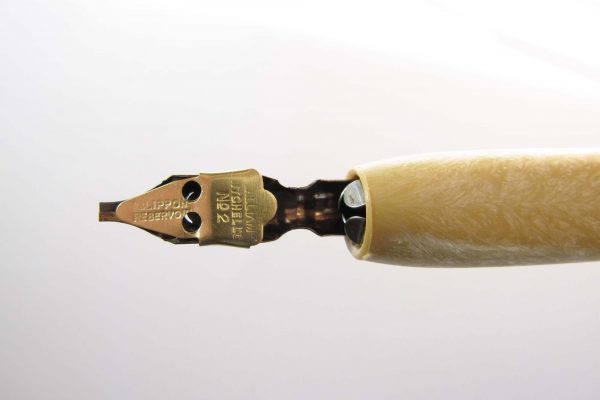
Fitting a Reservoir
There are two types of nibs: pointed and broad-edge. Pointed nibs do not use a reservoir, but broad-edge nibs do.
Some broad-edge nibs are purchased with a reservoir. These include Brause Bandzug nibs, Speedball ‘C’ and ‘LC’ nibs and Leonardt TAPE nibs. The obvious advantage of these broad-edge nibs is you do not need to fit the reservoir, which can be awkward to do until you get used to it.
Reservoirs for the William Mitchell Round Hand nibs and Leonardt Round Hand nibs are purchased separately and have to be fitted to the nib. So, you would be forgiven in thinking that you may as well purchase an edge-nib that already has a fitted reservoir. However, there are benefits in fitting the reservoir yourself. The distance of the reservoir to the tip of the nib helps control the ink flow. In turn, this can make it easier to use Gouache Paint on your nib instead of ink. And, as Gouache is a paint, it is possible to mix any colour rather than being limited to the colours available in the range of inks you are using.
Reservoirs
Reservoirs are usually made of brass making them flexible enough so they can be adjusted.

It is important to fit the reservoir correctly otherwise it can cause problems. If the reservoir is fitted too tight it can affect the tines of the nib causing scratchy pen strokes. If it is fitted too loosely it will fall off (usually down the sink or in the bottle of ink!). The fit needs to be such that the reservoir stays on the nib but could quite easily fall off.
Before you start
All pointed and broad-edge nibs need to be prepared before using them. This is to remove the protective coating and improve ink flow.
Fitting a Reservoir
Slide the reservoir on to the back of the nib. If the fit is too loose or tight, the reservoir can be adjusted by using both thumbs to adjust the little wings that wrap round the nib. Only minor adjustments are necessary. Pull the wings open slightly to loosen the grip, or gently close the wings a little by squeezing them with your thumbs to tighten the grip on the nib.

It is usual that each time you fit a reservoir you will need to adjust it for the nib. Some calligraphers overcome this by purchasing a reservoir for each nib.
Now the reservoir fits the nib correctly you need to make sure the tip of the reservoir is just touching the nib. Often it is necessary to bend the point of the reservoir a little.

Once the reservoir has been attached to the nib you will see a gap between the reservoir and nib. The tip of the reservoir should be touching the nib.

Controlling ink flow
Now the reservoir needs to be positioned correctly on the back of the nib. The position of the reservoir will control the ink flow.
Start with the reservoir about 2mm away from the tip of the nib. If the ink does not flow very well, slide the reservoir a little closer to the edge of the nib. If the ink flow is too great, reduce the flow by sliding the reservoir away from the nib.

Shop our range of Nibs and Reservoirs here.
